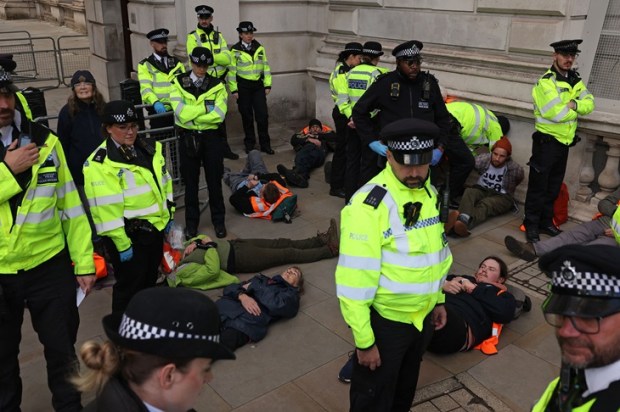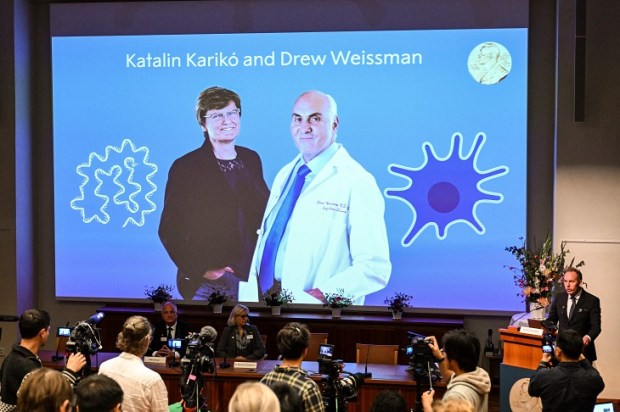Covid has been described as the ‘least deadly pandemic in history’ because its fatality rate among young, healthy people is a fraction of zero. Even for the elderly and sick Covid has barely managed to outpace Influenza, especially once you remove inflated ‘died with’ statistics. Once it settles into a seasonal pattern, it’s unlikely anyone will talk about it again. Covid will be remembered as a weird footnote in the year civilisation went mad.
Naturally, scientists have corrected this by creating a Covid strain that killed 80 per cent of infected mice.
Scientists at Boston University’s National Emerging Infectious Diseases Laboratories made the hybrid version of Omicron and tested it on human cells, finding it to be five times more infectious in addition to being deadly. The gain-of-function work was funded in part by the National Institutes of Health, and was subject to internal oversight but crucially not external review.
No one is suggesting that Boston University broke any rules, rather there is a hasty re-assessment of those rules going on as the public comes to terms with a nauseating amount of dangerous work being carried out in laboratories across the world.
Normally, protesting scientific research is the realm of animal rights activists who chastise laboratories for their treatment of mice, rats, and monkeys. There’s always been a bit of an ‘out of sight, out of mind’ approach by the general public but, after what happened with Covid, it’s time for ordinary people to take an interest in science (the business model).
Considering there is good evidence to support the accidental escape of the original Covid virus from the Wuhan Level-4 viral lab, it would be a good idea not to create an Ebola-version of Covid… And if researchers manage to make the case for the validity of their research, why not ship them to Antarctica to put a bit of frozen desert between any potential errors and the global population?
Crawling around in isolated bat caves, eating dodgy-looking bush meat, and splicing bits of deadly pathogen together are all activities that the human race needs to sit down and have a serious think about before proceeding. If ordinary businesses can’t afford the insurance for a customer slipping over and knocking their head, I’d love to know who is paying the insurance on labs fussing around with pandemic pathogens.
Gain-of-function experiments remain controversial as they have the potential to create highly transmissible and deadly viruses. They are meant to submit themselves to special external review, but there is an open debate as to whether this particular work with Omicron warranted such special attention. Those involved insist the research was conducted at a Level-3 biosafety lab. Okay, but Covid escaped from a Level-4 lab so forgive civilisation at large for asking the question…
Boston University refutes that their work includes gain-of-function research.
‘We want to address the false and inaccurate reporting about Boston University Covid research, which appeared in the Daily Maily. First, this research is not gain-of-function research, meaning it did not amplify the Washington state SARS-CoV-2 virus strain or make it more dangerous. In fact, this research made the virus replicate less dangerous.’
Not everyone agrees, considering this Omicron bastard-child was created by taking the spike protein from the Omicron virus and affixing it to a ‘backbone’ virus.
As their research paper notes:
‘In […] mice, while Omicron causes mild, non-fatal infection, the Omicron S-carrying virus inflects severe disease with a mortality rate of 80 per cent.’
To quote Science, ‘The scientists forced a huge amount of the virus up the noses of the mice, far more than a person would typically encounter. As a result, the mouse mortality rate of 80 per cent was far higher than the human mortality from the original SARS-CoV-2 variant, which is about 1 per cent.’
Lead author of the paper, Mohsan Saeed, released a statement stating:
‘Consistent with studies published by others, this work shows that it is not the spike protein that drives Omicron pathogenicity, but instead other viral proteins. Determination of those proteins will lead to better diagnostics and disease management strategies.’
That’s all well and good, but people would prefer that they checked all of this with the National Institute of Allergy and Infectious Diseases first. LiveScience notes that they also didn’t divulge that their experiments had the potential to create an enhanced pathogen of pandemic potential (ePPP). Those are meant to go through a committee.
‘What we would have wanted to do is talk about exactly what they wanted to do in advance, and if it met what the P3CO framework defines as enhanced pathogen of pandemic potential, ePPP, we could have put a package forward for review by the committee that’s convened by HHS,’ said Meily Erbelding, director of their microbiology and infectious diseases division.
Quite rightly, there has been public backlash.
‘This should be totally forbidden, it’s playing with fire,’ said Israeli scientist Professor Shmuel Shapira.
Rutgers University chemist Dr Richard Ebright also voiced concern about how easily this research was conducted.
‘If we are to avoid the next lab-generated pandemic, it is imperative that oversight of enhanced potential pandemic pathogen research be strengthened.’
Remember, you’re likely to go to jail for texting while stopped in traffic, but the university next to you is allowed to play with pathogens which, for the last two years, brought the world to its knees and killed 6.5 million people – not to mention facilitating the largest transfer of wealth from the middle class to the rich in history.
Perhaps worse is the admission by one of the officials involved in oversight of the facility that they were unaware of specific experiments. But don’t worry, we’re told, because previous publications of similar studies did not cause alarm.
Someone may need to remind scientists that just because the public didn’t know what they were up to, doesn’t make everyone supportive of their work. Silence is not consent.
‘Mother Nature did it already a while ago in humans and nobody cared,’ tweeted virologist Florian Krammer, from the Icahn School of Medicine at Mount Sinai.
Sure. Nature also made Anthrax but that doesn’t mean you’re at liberty to cook it up in your garage.
In discussing this particular experiment, Boston University admitted it had been doing studies that involved playing around with bat viruses, just as the team in Wuhan had done – most of which are never reviewed by an authority figure. Science notes that the US Food and Drug Administration created their own deadly Omicron variant earlier in the year, the only difference appears to be that Boston University was more honest about the nature of what they created instead of hiding the details behind ‘science-speak’.
There’s a reason we adopted the mad scientist trope and why, instead of blindly ‘trusting the science’ we used to remain cautious of the angelic intentions of Big Pharma.
What these trials reveal is that researchers around the world have been operating in darkness for too long. They have taken too many risks, without public oversight, with our global health. As far as we can tell, no scientific body has been punished for Covid, despite it being solely the fault of human error. How can that be?
In the end, instead of saving people from a pandemic, they caused one.
For those who blindly shout at us, ‘trust the science’, I’m sure we’d trust the scientific community a lot more if they didn’t use civilisation as a Petri dish, human beings as fodder for experiments, and Big Tech as their enforcers.
You can read the statement from Boston University below:
Boston University statement on following National Institute of Allergy and Infectious Diseases (NIAID) guidelines:
‘We fulfilled all required regulatory obligations and protocols. Following NIAID’s guidelines and protocols, we did not have an obligation to disclose this research for two reasons. The experiments reported in this manuscript were carried out with funds from Boston University. NIAID funding was acknowledged because it was used to help develop the tools and platforms that were used in this research; they did not fund this research directly. NIH funding was also acknowledged for a shared instrumentation grant that helped support the pathology studies. We believe that funding streams for tools do not require an obligation to report. Secondly, there was no gain of function with this research. If at any point there was evidence that the research was gaining function, under both NIAID and our own protocols we would immediately stop and report. All research at Boston University, whether funded by NIAID or not, follows this same protocol. We are in continued conversation with NIAID leadership and program officers.’
Got something to add? Join the discussion and comment below.
Get 10 issues for just $10
Subscribe to The Spectator Australia today for the next 10 magazine issues, plus full online access, for just $10.


























Comments
Don't miss out
Join the conversation with other Spectator Australia readers. Subscribe to leave a comment.
SUBSCRIBEAlready a subscriber? Log in